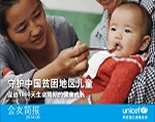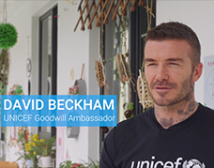UNICEF updates guidelines for reporting on children's issues
Documenting abuses while protecting children at risk
By Ellen Tolmie and Rebecca Fordham
NEW YORK, USA, 6 August 2010 – UNICEF has updated its guidelines for reporting on children's issues as part of the continuing global effort to ensure every child's right to protection and dignity.
Grounded in the principle that children's rights must be respected in all circumstances, the guidelines focus particularly on those who may be at risk of harm – including physical danger, psychological coercion or social stigmatization – if they are identified in media reports.
Identity protection in risk situations
The need for greater identity protection for some children became increasingly evident in international reporting during the 1990s. There were two main reasons for this: first, a rise in the number of conflicts that targeted civilians, including children; and second, a heightened awareness of the full range of children's rights and their violation.
Some of the most egregious forms of violation include forcing children into armed conflict or sexually exploiting them. Children who suffer these abuses may risk being traumatized or stigmatized if their identities are publicly disclosed. The same holds true for children who are HIV-positive, or those who are charged or convicted of crimes.
UNICEF supports rigorous media coverage of child rights violations because reporting is crucial to raise awareness of their existence and advocate for putting a stop to them. But advocating against human rights abuses can also put individual children at risk of additional physical or psychological harm.
When to protect identities
"We have witnessed many instances where children have been further endangered or stigmatized after their stories are published,” notes UNICEF's Chief of Child Protection, Susan Bissell. “Protecting against this requires that reporting on children in high-risk situations also respects their individual rights to privacy, to participate in decisions affecting them, and to protection.”
To ensure respect for these rights, UNICEF's internal policies and external guidelines call for protecting the identities of children whenever publication of their stories may put them at risk.
UNICEF policy also requires that requests for identity protection from any child (or the child's guardian) must be respected in all circumstances – whether or not they involve sexual exploitation, HIV/AIDS, criminal justice or child combatants.
Protecting the visual identities of child victims of sexual abuse has long been broadly supported; indeed, such protection is mandated by many countries' national laws. This is partly because pornography (a visual depiction of sexual exploitation) is often an aspect of the abuse. Publishing the identities of sex abuse victims further exposes an intimate suffering that can deepen the sense of powerlessness and humiliation caused by the original violation.
In many communities around the world, identifying victims further stigmatizes them and increases their risk of future abuses.
Nevertheless, stopping sexual exploitation requires documentation of its pervasiveness. And cultural taboos against publicizing or even acknowledging the existence of sexual abuse can increase risks and give victims little recourse when it happens.
Non-sensational coverage of child soldiers
A parallel dynamic is at work in documenting the issue of child soldiers.
Media reports exposing the use of child combatants make a vital contribution to greater awareness of this gross exploitation and the global campaign to stop it. But to ensure that individual children are shielded against possible reprisals, stigma or worse, UNICEF protects the identities of all former or current child soldiers judged to be at risk.
This policy also protects against the sensational use of images that show armed child soldiers acting or posing as aggressors – including all those holding weapons.
Of course, armed child soldiers are threatening and dangerous (and are often drugged or otherwise de-sensitized to the damage they can do). As children, however, they are also, by definition, forced combatants. While recognizing the importance of reporting on them, UNICEF emphasizes their status as children and coerced victims, a status that is much harder to emphasize if they are represented in sensationalized ways.
Imagery that protects children
To address the challenge of protecting the visual identities of children at risk, UNICEF works with professional photographers and videographers who have demonstrated a key point: Imagery that fully protects the subject's identity can be as powerful and convincing as any other approach to documenting abuses.
Creating such imagery often means allowing children to participate in the act of protection – by, for example, turning away from the camera or covering their faces. The result, far from being banal or evasive, dramatically represents the situation of at-risk children, underscoring the need for protection while also preserving their dignity.
UNICEF imagery that provides this level of protection demonstrates the power of photography and videography to document harsh realities while safeguarding child rights.
































